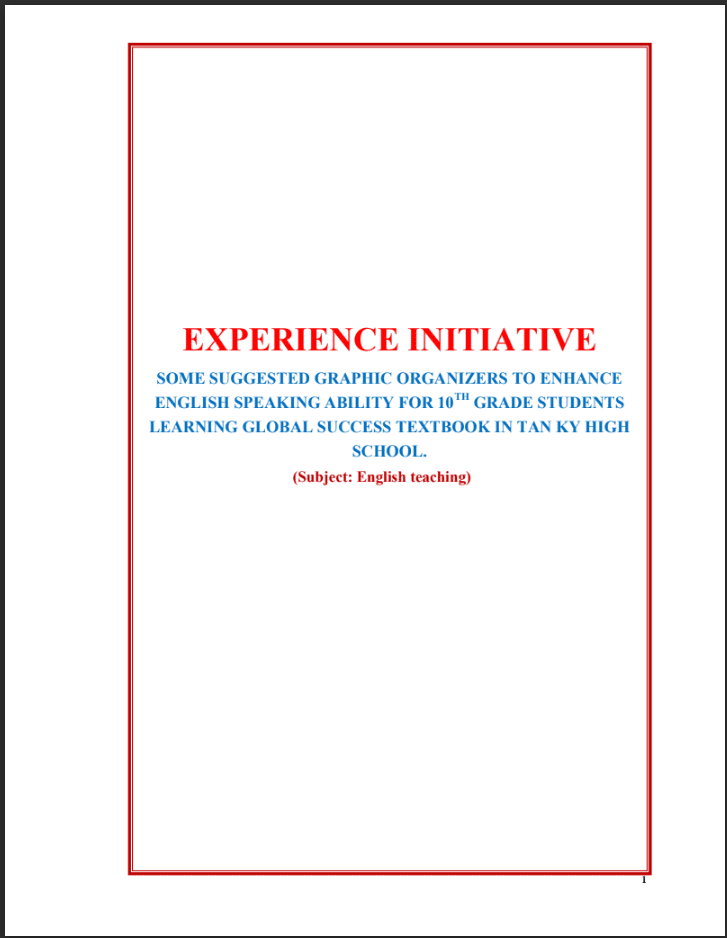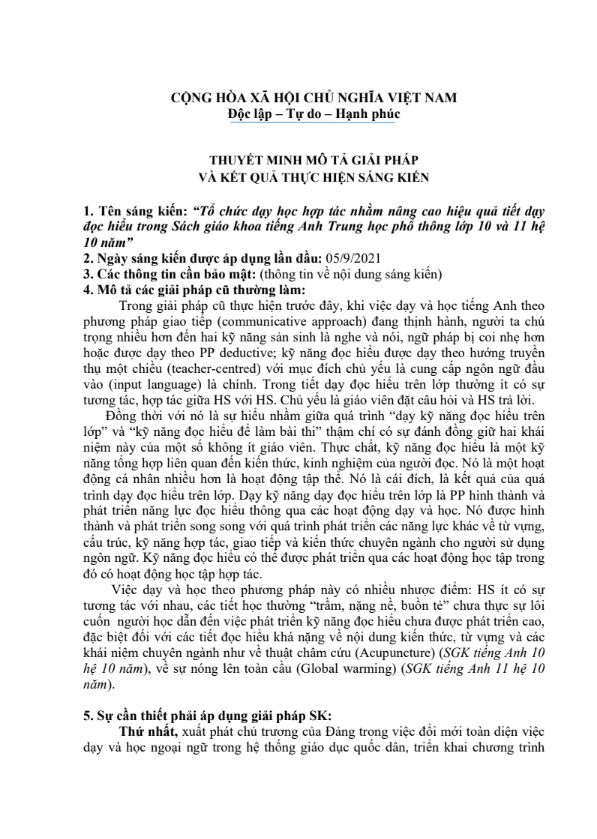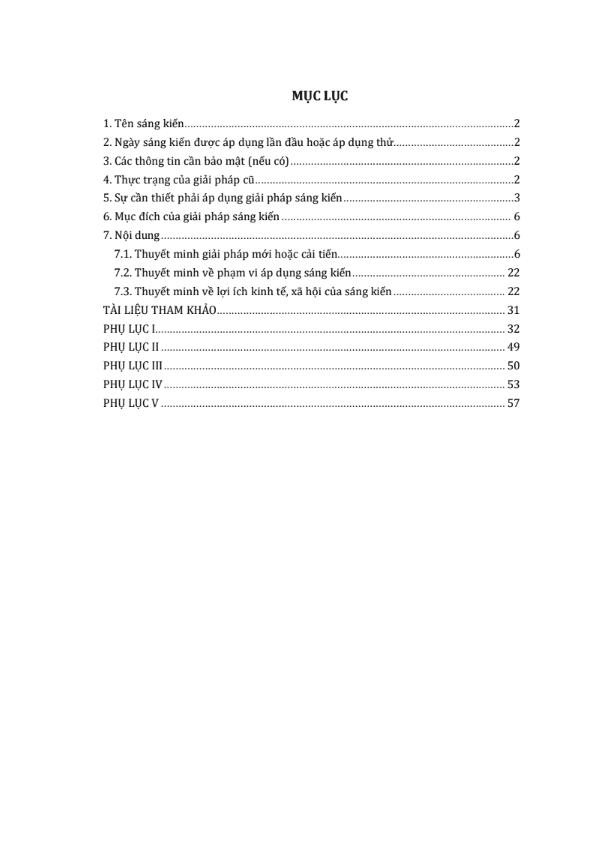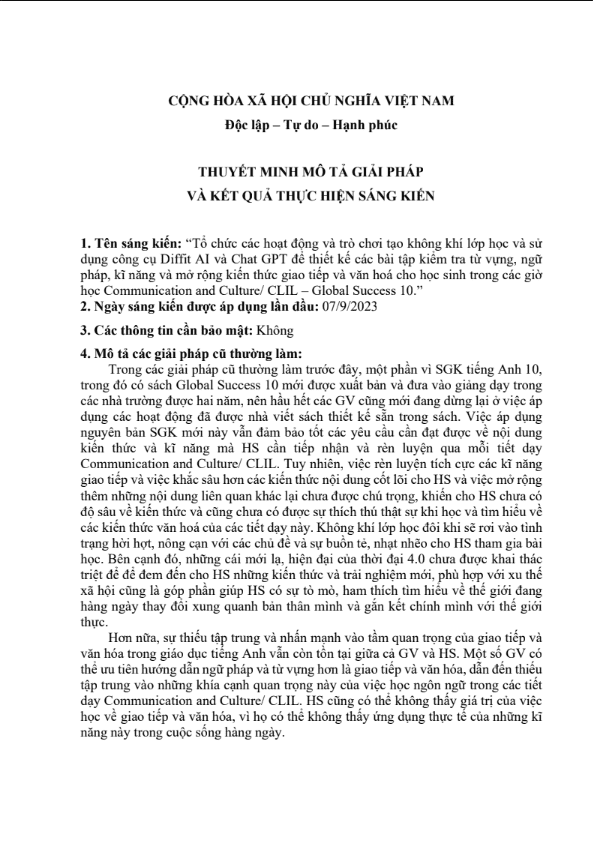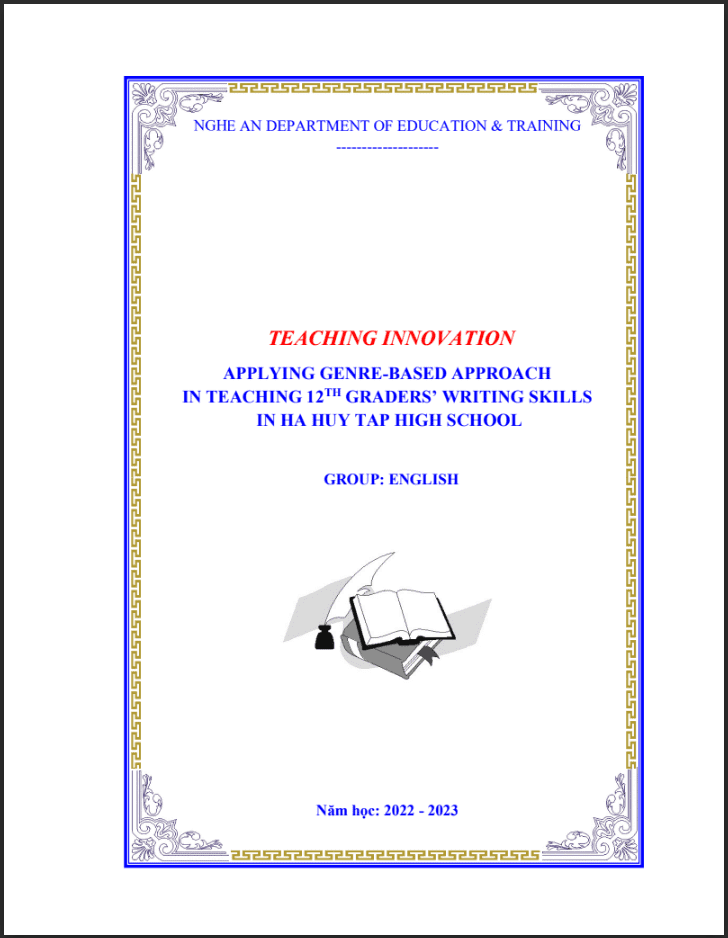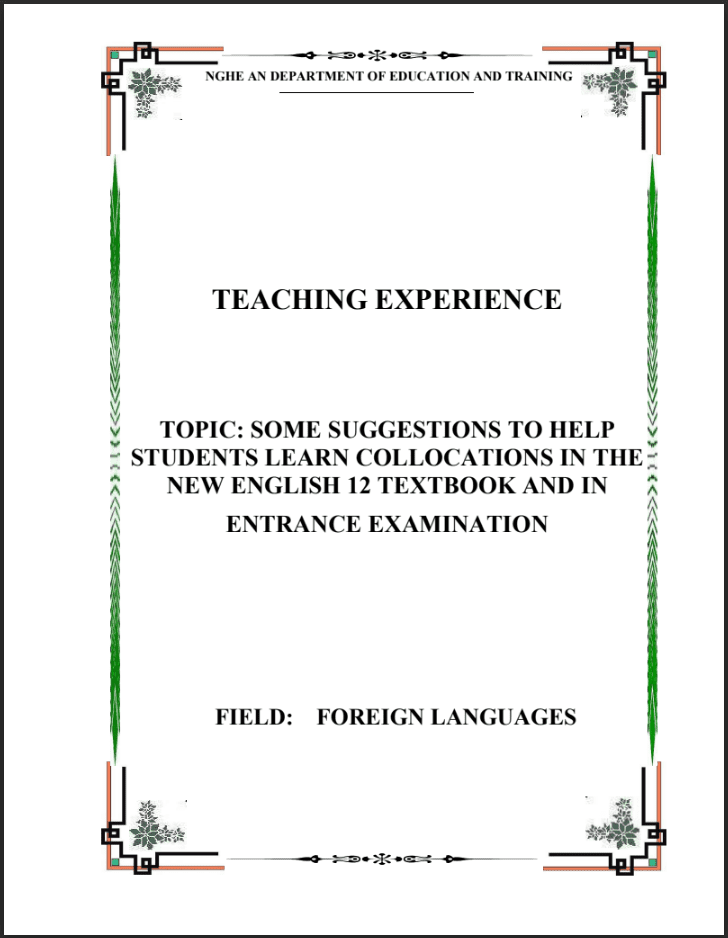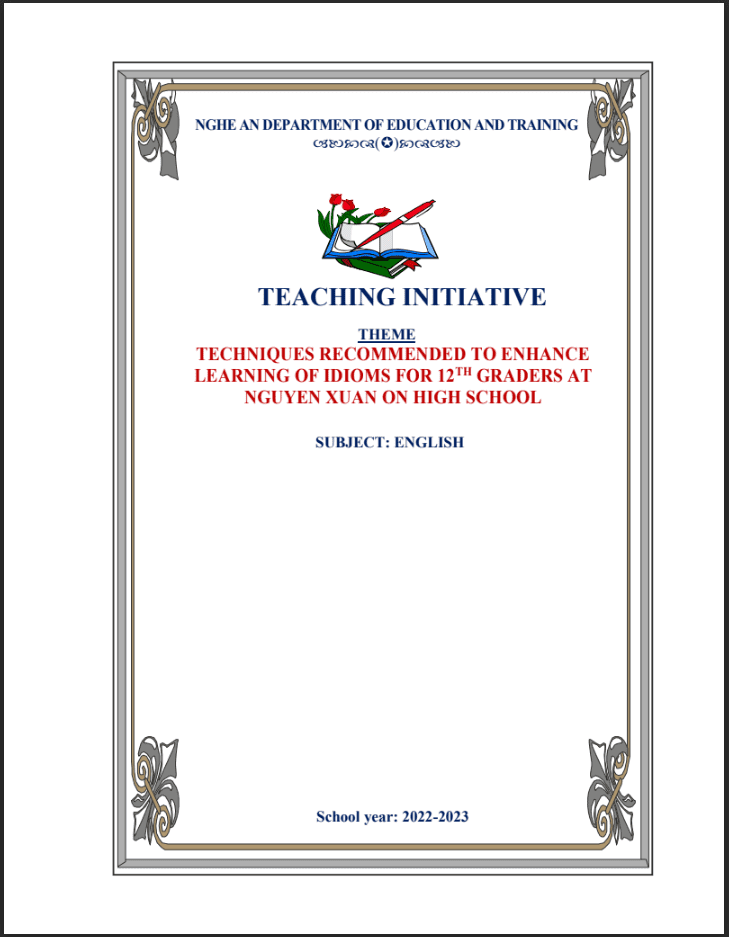SKKN Some suggested graphic organizers to enhance English speaking ability for 10th grade students learning Global Success textbook in High school.”.
- Mã tài liệu: MP0079 Copy
| Môn: | Tiếng Anh |
| Lớp: | 10 |
| Bộ sách: | Global Success |
| Lượt xem: | 592 |
| Lượt tải: | 6 |
| Số trang: | |
| Tác giả: | Trần Thị Thanh Hương |
| Trình độ chuyên môn: | Thạc sĩ giáo dục |
| Đơn vị công tác: | THPT Tân Kỳ |
| Năm viết: | 2022-2023 |
| Số trang: | |
| Tác giả: | Trần Thị Thanh Hương |
| Trình độ chuyên môn: | Thạc sĩ giáo dục |
| Đơn vị công tác: | THPT Tân Kỳ |
| Năm viết: | 2022-2023 |
Sáng kiến kinh nghiệm “Some suggested graphic organizers to enhance English speaking ability for 10th grade students learning Global Success textbook in High school.”.”triển khai gồm các biện pháp nổi bật sau:
Mô tả sản phẩm
PART I. INTRODUCTION
1.1. Rationale for the study
Along with the globalization trend, English becomes an important subject in the curriculum of both state schools and private ones from primary schools to universities in Viet Nam. In this context, the teaching and learning of English is considered as a significant duty for Ministry of Education and Training as well as all teachers of English. In recent years, teaching and learning English as a foreign language has gained considerable progress both in scale and quality. However, there is still a gap in English teaching and learning outcomes between rural and urban areas. The fact is that the teaching and learning of English has not been effective in rural areas yet. One of the differences between the learners in cities and rural areas is the learners‟ ability to speak English. There are still many people learning at rural areas cannot use English well after finishing English courses. Tan Ky, a remote and mountainous area, belongs to one of the rural areas of Nghe An where the learners‟ speaking skill is much limited. This problem comes from many different causes, including objective and subjective reasons.
According to Brown and Yule (1983), speaking is the skill that the students will be judged upon most in real-life situations. It is an important part of everyday interaction and most often the first impression of a person is based on his/her ability to speak fluently and comprehensively. So, teachers have a responsibility to prepare the students as much as possible to be able to speak in English in the real world outside the classroom. Despite its importance, for many years, teaching speaking has been undervalued and English language teachers have continued to teach speaking just as a repetition of drills or memorization of dialogues. However, the world now requires that the goal of teaching speaking should improve students’ communicative skills, because, only in that way, students can express themselves and learn how to follow the social and cultural rules appropriate in each communicative circumstance.
As a teacher of English at a rural upper secondary school, the researcher is concerned about her students‟ English learning, especially, in speaking skill. She has been teaching 2 classes of grade 10. Although her students have learnt English since they were in grade 3 with the new syllabus and new methods applied with the communicative approach, their spoken English in the real world is still restricted . They hardly use English to communicate for fear of making mistakes, lack of vocabulary, wrong pronunciation and others. So the question is put for the researcher what teachers should do to help their students learn spoken English better in this rural environment, where the English language input is poor and the chances to practice spoken English are limited. The researcher has thought a lot about this fact and decided to conduct the study on “Some suggested graphic organizers to enhance English speaking ability for 10th grade students learning global success textbook in Tan Ky High school.”. The researcher implements this study with the hope to find out a suitable method to improve the learners‟ speaking skill in real life at local.
1.2. The purpose of the study
This study aims at suggesting some adaptations using graphic organizers in teaching speaking skill in textbook English 10 – global success.
1.3. The scope of the study
The study was carried out at Tan Ky High School with the total of students relating to 80 EFL 10th graders who come from class 10d4 and class 10d5 of Tan Ky High School. The learners are divided into two groups, the control group and the experimental group. The study is aimed to investigate the effectiveness of graphic organizers in teaching speaking skill as well as the learners‟ attitude toward this technique. The time for studying lasts from the September 2022 to March, 2023.
1.4. The significance of the study
The thesis provides for ESL teachers the deeper understanding of applying graphic organizers in teaching speaking skill. The study will be the significant source of reference for ESL teachers at rural areas. In addition, the study will supply for the ESL teachers at Tan Ky district the new approach to apply graphic organizers in teaching. The result of the study is believed to make a great contribution to the success of teaching speaking skill in common.
PART II. CONTENT
2.1. Overview of speaking skill.
2.1.1. Definition of speaking.
According to Longman Dictionary, speaking is the utterance of intelligible speech or seeming to be capable of speech. Speaking is the process of orally expressing thought and feelings of reflecting and shaping experience, and sharing information. Speaking is a complex process, which involves thinking language and social skills. The speaker combines words to sentences and paragraphs and use a language style that is appropriate to a social context. Speaking is developing for the relationships between a speaker and her hearer. In addition, speaking is determining which logical linguistic, psychological and physical rules that should be applied in a given communicative situation
Tarigan (1990:3-4) defines that speaking is a language skill that is developed in child life, which is produced by listening skill, and at that period speaking skill is learned.
2.1.2. What is teaching speaking?
Teaching speaking is to teach our learners to:
- Produce the English speech sounds and sound patterns.
- Use word and sentence stress, intonation patterns and the rhythm of the second language.
- Select appropriate words and sentences according to the proper social setting audience, situation and subject matter.
- Organize their thoughts in a meaningful and logical sequence. – Use language as a means of expressing values and judgments.
- Use the language quickly and confidently with few unnatural pauses, which is called as fluency (Nunan 2003).
2.1.3. Approaches to teaching speaking
According to the theories of first and second language, Thornberry (2005; see also Leighton & Spade, 2006; Brown 2007) refers three theories of language learning relating to the speaking teaching. They are behaviorist, cognitive and socio-cultural theory.
According to behaviorist, language is learned by “forming good habits through reinforcement” (Thornbury, 2005, p.38). The process of learning speaking follows presentation, practice, controlled production. The major purpose of the process is to form automatic habits. Firstly, EFL learners listen to teacher or a tape, videos. Then, they practice by drilling, retell, show and tell, etc. Finally, learners perform their product in front of the class.
According to cognitivists, learners‟ minds are expected as black boxes with the capacity of information processing. Speaking skill is examined to be developed through learning stages that range from being controlled to automatic. Learning first pays attention to awareness-raising of specific stages of a procedure, then changes to integrate the newly acquired knowledge and existing knowledge through practice and ends with self-controlling.
In sociocultural theory, Thornbury (2005) and Lightbown & Spada (2006) states that the socio-cultural situation is significant in learning and they also express that learning is conducted through social interaction and with other learners. Learners need to have other-regulation, mediation of somebody who has better knowledge and can provide a supportive framework which can be like scaffold. Learners interact with partners, teachers etc and the interaction permits them to build new knowledge until they gain the appropriate level. They turn the knowledge into their own and can act themselves.
TÀI LIỆU LIÊN QUAN
- 7
- 105
- 1
- [product_views]
- 5
- 173
- 2
- [product_views]
- 4
- 165
- 3
- [product_views]
- 4
- 129
- 4
- [product_views]
100.000 ₫
- 6
- 434
- 5
- [product_views]
100.000 ₫
- 2
- 507
- 6
- [product_views]
100.000 ₫
- 9
- 546
- 7
- [product_views]
100.000 ₫
- 4
- 409
- 8
- [product_views]
100.000 ₫
- 2
- 595
- 9
- [product_views]
100.000 ₫
- 0
- 538
- 10
- [product_views]

